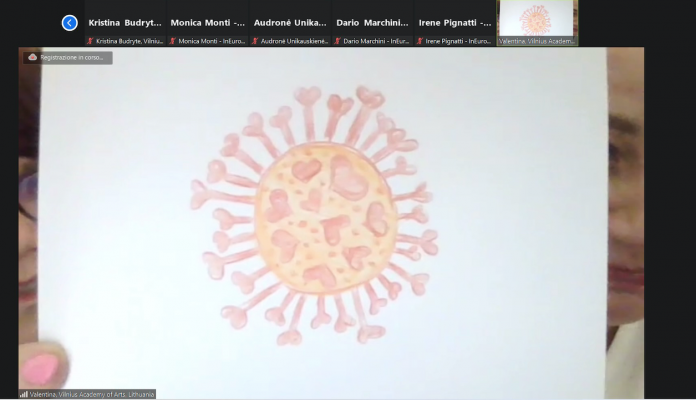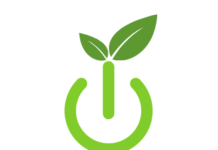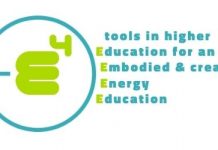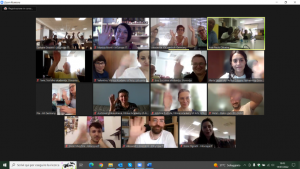 Yesterday, 14th July 2022, it was held virtually on Zoom the first Digital Storytelling Cafè of the ArtDiCo project, reserved to the participants of the Digital StoryTelling organised in each of the 7 partner countries of the project (Italy, Germany, Greece, Lithuania, Slovenia, Belgium and Portugal). Each partner contributed to ease online participation of their local groups, by connecting together to support communication in English among participants and co-participatory activities.
Yesterday, 14th July 2022, it was held virtually on Zoom the first Digital Storytelling Cafè of the ArtDiCo project, reserved to the participants of the Digital StoryTelling organised in each of the 7 partner countries of the project (Italy, Germany, Greece, Lithuania, Slovenia, Belgium and Portugal). Each partner contributed to ease online participation of their local groups, by connecting together to support communication in English among participants and co-participatory activities.
The ArtDiCo project (Art, Digitality and Corona: digital storytelling for people with little digital literacy – new e-learning approaches), financed by the Erasmus+ programme, has created a promotional digital storytelling for people with little media literacy on the base of their Covid-19 pandemic experiences. They have been taught to make use of the virtual space, engaged in the artistic sector and have learnt to express themselves creatively thanks to the constant support of educators and through an experimental pathway, leading to the results presented during the virtual Digital Storytelling Cafè.
The Cafè stood as a great challenge, successfully overcome thanks to the empathy and the coordination among the 7 project partners, which worked very well although online. The aim of the virtual Cafè consisted in allowing participants to share their own works (digital strategies created during the ArtDiCo pathway on the topic of Art and Corona) and compare their own thoughts, opinions, emotions and feelings on the theme and their experience during the pandemic, while giving feedback on the impact the project has had on their lives.
The challenges we dealt with were:
- The use of the English language – several participants do not speak and understand English, thus partners eased the exchange at international level by providing them linguistic support to let them freely express, as well as to make the others understand and interact. Interaction was made possible thanks to non-verbal activities, i.e. drawings and choice of pictures representative of thoughts, feelings and emotions that could be easily shared.
- Being in a virtual environment, without knowing the others while dealing with a sensitive topic on personal experiences about Coronavirus – we managed to create a friendly and comforting environment for all, while leaving space to all videos and respecting the wishes of all authors
- Length and attention: the event lasted 2 hours and a half, which passed by very easily due to the intensity of the interaction created and the eagerness from all participants to listen to and see the others’ works; despite being reproduced in their mother tongues and subtitled in English, everybody’s messages reached the audience vividly and clearly and touched all participants.
The virtual cafè stands an effective moment of confrontation to talk about a given topic in an informal, although organised, manner. The narration is always a socialising occasion and, after the Covid-19 pandemic, for several people the need to find a place (either virtual or physical), share their own stories and listen to the others’ ones has grown stronger and stronger. It is in this context that the storytelling cafè was put in place, thanks to the friendly atmosphere it can recreate.
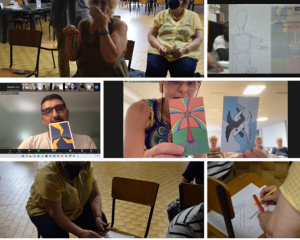 Overall, 18 videos were shown. In the first part of the meeting, following a brief introduction from all partners, 11 out of 17 videos were projected. They were realised in participants’ mother tongues with English subtitles; consequently, in order to allow all participants to express their own emotions beyond the language barriers, some illustrated cards were used whose significance is universal and makes words unnecessary.
Overall, 18 videos were shown. In the first part of the meeting, following a brief introduction from all partners, 11 out of 17 videos were projected. They were realised in participants’ mother tongues with English subtitles; consequently, in order to allow all participants to express their own emotions beyond the language barriers, some illustrated cards were used whose significance is universal and makes words unnecessary. 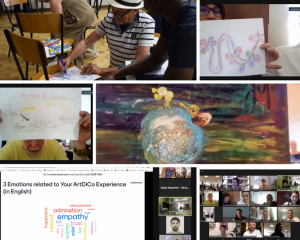 Afterwards, the remaining videos were displayed and participants were invited to on-the-spot drawing, in order to make them immediately paint their emotions and reactions to the stories. It was left space for creativity and fantasy: somebody drew the sea, someone else the world as the virus, while others expressed hope in the future through paintings.
Afterwards, the remaining videos were displayed and participants were invited to on-the-spot drawing, in order to make them immediately paint their emotions and reactions to the stories. It was left space for creativity and fantasy: somebody drew the sea, someone else the world as the virus, while others expressed hope in the future through paintings.
The activity was conducted with great success and everybody actively participated, particularly referring to the Italian group who reunited in presence at the S. Catherine’s church of Modena and shown great enthusiasm, desire for collaboration and confrontation, thus stimulating all other groups. Learners also did a very good job by learning how to use digital tools and preparing the videos on their stories during the Coronavirus pandemic.
The aspect which mostly emerged from the event and the sharing activities was the surprise of expressing the same sentiments, selecting the same pictures, catching the same feelings and perceptions of living during the months of the pandemic, also through drawings. 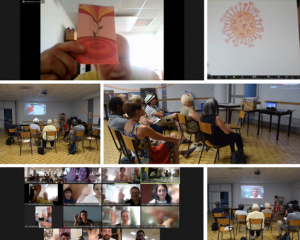 The stories showed how people, in the darkest moments, tried to create an opportunity to let the light of hope emerge by learning to adapt and change, hoping for a rebirth. All this was demonstrated in an involvement climax, from the starting shyness and the obstacle of communicating in English, to the exchange and direct reaction to the chosen pictures which were progressively presented, shared and described.
The stories showed how people, in the darkest moments, tried to create an opportunity to let the light of hope emerge by learning to adapt and change, hoping for a rebirth. All this was demonstrated in an involvement climax, from the starting shyness and the obstacle of communicating in English, to the exchange and direct reaction to the chosen pictures which were progressively presented, shared and described.
In particular, the ArtDiCo pathway has allowed people to develop new digital skills together with deeper knowledge of the art and its force, but has mostly permitted participants to uncover their personal emotions and feelings with respect to their personal lives during the pandemic, thus succeeding in making them use digital means as effective tools to narrate themselves, break personal barriers, express and put themselves to the test. What emerged from their feedback was that they ultimately managed to elaborate their own life and sufferings in a creative, expressive and comprehensible way at global level, beyond their national languages, thanks to the project.

